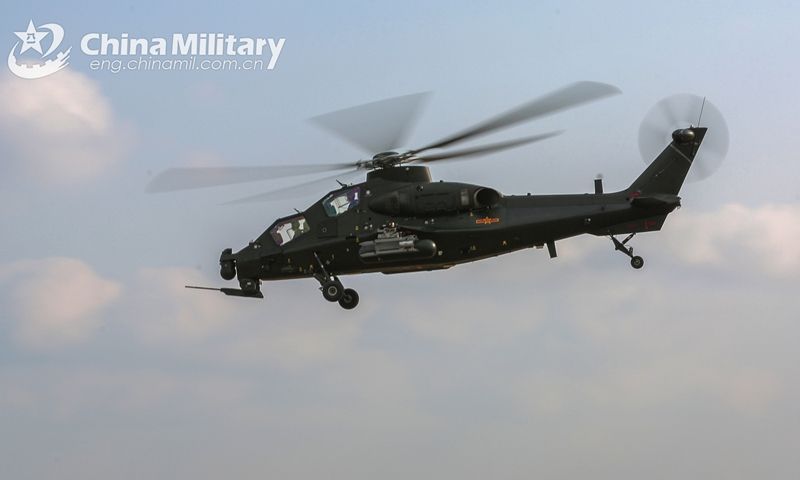China’s PLA has reportedly conducted a force projection drill recently, involving attack and transport helicopters to enhance coordination between troops and air forces.
The transport helicopters carrying special operations troops flew to the target area under the cover of attack helicopters, “where reconnaissance helicopters guided ground and air firepower to clear and suppress the mock enemy defense forces in the landing zone”. This was to ensure the safe landing of transport helicopters, reported China Military Online.
The army aviation brigade has been conducting air-landing operations, air-ground coordination, and other realistic combat drills in various terrains since the beginning of 2021. It is believed that the brigade is committed to the transformation from a transportation support force to the main assault force of the PLA army.

Recently, a PLA joint military brigade also conducted “real combat drills” encompassing anti-nuclear, chemical, and biological warfare in Tibet in the backdrop of the ongoing Sino-India border tension in eastern Ladakh.
The WZ-10 was one of the attack helicopters deployed by the PLA Army aviation brigade in the drills, as seen in a video. The helicopter was previously in the news when the PLA dispatched it alongside a Mi-17 delivery helicopter to Taiwan’s Air defense identification zone for the first time on October 26.
WZ-10 Attack Helicopter
Changhe Aircraft Industries Group (CHAIG) and China Helicopter Research and Development Institute (CHRDI) worked together to develop the Z-10 attack helicopter. Anti-armor and combat interdiction operations are the primary missions for the Z-10 assault helicopter.
It is also capable of limited air-to-air combat. In April 2003, the Z-10 helicopter took to the skies for the first time. In 2009, the PLA received its first helicopter. The Z-10 made its debut in November 2012 at the 9th China International Aviation and Aerospace Exhibition in Zhuhai.

A huge controversy broke out almost a decade back involving the Chinese Z-10 chopper. United Technologies, as well as its subsidiaries Pratt & Whitney Canada and Hamilton Sundstrand, pled guilty in June 2012 to violating the Arms Export Control Act and making false statements about the illegal export of US-made military software for the Z-10.
As part of a global settlement relating to Chinese arms export breaches, the businesses were obligated to give the US government more than $75 million.
The Z-10 has a conventional attack helicopter layout with a fuselage that is nailed down and stepped tandem cockpits. The fuselage is tapered to the rear for a smaller radar crosssection, with a sloped side. The helicopter has a four-bladed tail rotor and a five-bladed main rotor.
At the rear of the cockpit, two engines are installed. The helicopter is 14.1 meters long, with a rotor diameter of 13 meters and a height of 3.8 meters. The Z-10’s maximum take-off weight is 8 tonnes. The stepped tandem cockpit accommodates a gunner in the front and the pilot in the rear on ejection seats, according to Army Technology. Composite armor protects the cockpit, whose glass canopy can withstand 7.62mm bullets.
The modern glass cockpit is equipped with multifunctional displays (MFDs), a helmet-mounted sight with night vision goggles, and a fly-by-wire (FBW) control system. A 20mm or 30mm autocannon can be installed on the chin-mounted turret.

Four hardpoints for external weapons are provided by two stub wings. The GJV289A common databus architecture enables the integration of both Soviet and Western armament systems.
The WZ-10 is China’s first modern attack helicopter designed and produced domestically. The HJ-10 anti-tank guided missile can also be used by the helicopter (ATGM), which is believed to be similar to the American AGM-114 Hellfire.
A WZ-10 attack helicopter attached to an army aviation brigade under the PLA 80th Group Army lifts off for a round-the-clock flight training exercise on Nov 19. https://t.co/Qu8P3hyedK pic.twitter.com/nGdyEtt3DY
— Global Times (@globaltimesnews) November 28, 2020
The helicopter can carry up to eight anti-tank guided missiles (ATGMs), eight TY-90 air-to-air missiles, and four PL-5, PL-7, and PL-9 air-to-air missiles.
The TY-90 missile is designed primarily for helicopters that conduct aerial combat missions. For ground assault missions, the Z-10 can also carry multibarrel unguided rocket pods. Four pods under the sub wings can house 57mm-90mm rockets in total.
Two Pratt & Whitney Canada PT6C-67C turboshaft engines power the Z-10. Full Authority Digital Engine Control (FADEC) is installed in the engines. Each engine has a continuous power output of 1,142kW.
- Contact the author at ashishmichel@gmail.com
- Follow EurAsian Times on Google News




